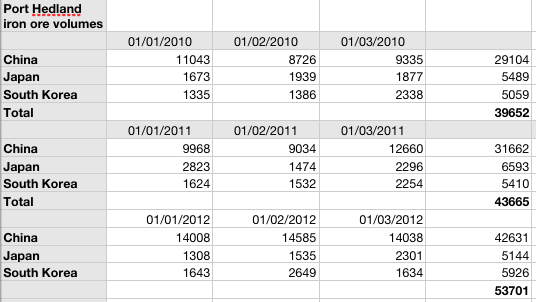The twin pillars of Australia’s boom, iron ore and coking coal, continue to diverge. Yesterday the iron ore price broke more decisively out of its post crash trading range, up half a percent or so to $148.70. To say the least, this is a finger in the eye for China bears.
Here is the spot price chart:

The 12 month futures are also rallying though not yet to new highs:

Port Hedland shipments for March out too and show a boom month not to mention quarter:

That’s up 23% in a year and 35% over two. Iron ore volumes to China continue to be epic.
Here is the recent RBA chart indicating contract price levels sitting somewhere just above $140:

There’s been a lot of bluster by the big miners about selling most of their ore on the spot market, especially from BHP. It’s certainly true of Fortescue, as the crash in the price paid for their ore in Q4 showed. But Rio and BHP still constitute the vast majority or iron ore shipments and the big correction in the Australian trade balance in January showed that the vast majority of ore is still shipped on contract. If prices hold, the April trade balance will see national iron ore revenues grow a couple of percent.
On the other hand, coal remains weak and it’s starting to filter through to projects. BHP announced overnight that it will close the Bowen Basin coking coal mine, Norwich Park. The company (or the AFR) has blamed unions for the closure and no doubt rising costs are a part of the issue but there’s no doubt the big falls in the coking coal price from $330 a tonne to $200 a tonne is the real problem. From the AFR:
The world’s biggest coking coal producer has shut a mine in Queensland’s Bowen Basin, putting 1400 jobs at risk, after repeatedly warning that the project might not survive the industrial action sweeping the region.
The BHP Billiton Mitsubishi Alliance has indefinitely closed Norwich Park, near the town of Dysart, and said floods which devastated the state last year, lower coal prices and high costs had made the operation uneconomic.
The decision will affect more than 490 permanent workers, 910 contractors and cost about $400 million a year in revenue.
As I’ve mentioned before, rumours of cuts to coal mining plans have been circulating for several months. BHP appears to have taken the opportunity of the strike to shift the blame of the closure onto unions.
On the volumes front, the AFR recently had some aggregated figures:
Sales at the Queensland coal export ports of Dalrymple Bay, Hay Point, Gladstone and Abbot Point were down 14 per cent in the three months to the end of March against the December quarter, but up 24 per cent year-on-year.
Overall, 36.8 million tonnes of coal was exported from those ports in the first quarter of this calendar year, according to data compiled by The Australian Financial Review.
At Hay Point, wholly owned by the BHP Billiton-Mitsubishi Alliance, exports fell only 1 per cent to 7.8 million tonnes in the March quarter from the previous three months. Despite ongoing industrial action, shipments were still 34 per cent higher than the rain-affected March quarter of last year. However, the impact of industrial action became more marked as 2012 progressed.
These may be up on last year’s rain-affected shipments but the AFR neglects to mention that they around or below the same as the year before. This is largely a demand weakness story, indicating North Asia is struggling.
I guess we’re used to China pumping out contradictory data. Now it’s apparent in our two major exports.
The above coal contract chart shows we’re sitting at roughly $230 a tonne so there is another 10% or so price fall to filter through in April (including thermal coal). I continue to think that the balance of these price and volume outcomes will be an ongoing trade deficit.

